Note: This essay was originally going to be a single post, but when I asked my friends for their travel tips, they responded with so many great ideas that I have expanded the topic into two posts in order to include as much advice as possible. This week will feature personal and practical tips, and next week we’ll discuss paradoxical and philosophical thoughts on travel.
The other day, after arriving home from our most recent trip to Italy, I was casting about for an essay topic, when it hit me: Travel tips! Duh! As our family’s official travel concierge, I have plenty of experience with organizing trips, and plenty of ideas for how to make trips as stress-free, enriching, and fun as possible.
To paraphrase Shakespeare, the first thing we do, let’s pet all the dogs (or, I grudgingly concede, the cats):


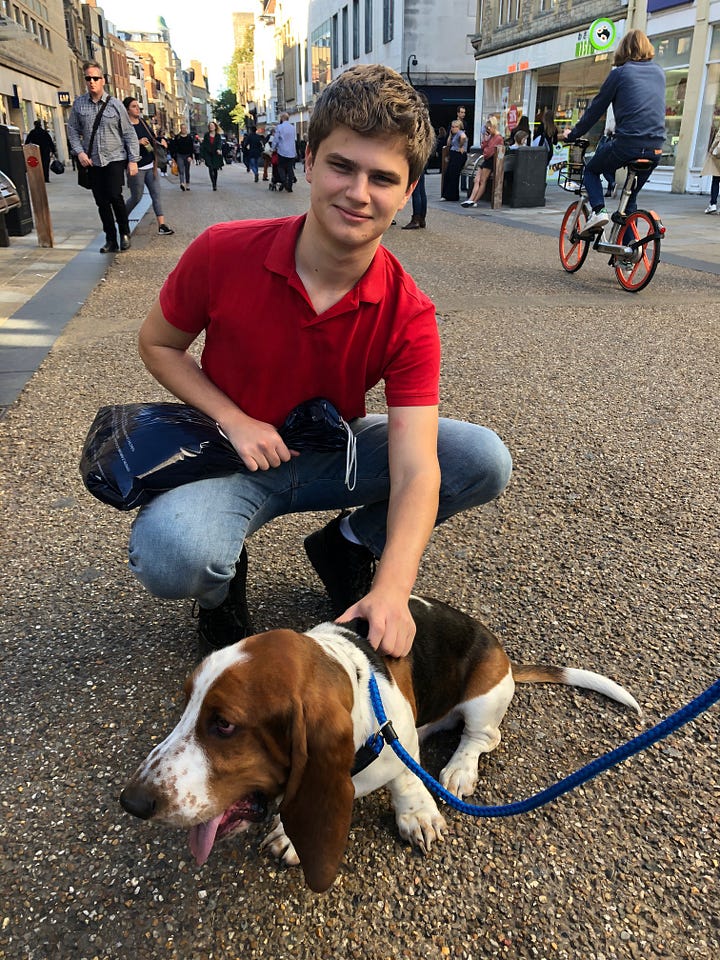

Petting dogs is a terrific, low-key way to meet local people and engage in friendly chit-chat with them. Of course, always ask if it’s ok first! Asking is not only polite but also provides the opportunity for a quick language lesson. My daughter, Casey, has learned to say “Is he friendly?” or “May I pet your dog?” in several languages for this very purpose. We have found that people enjoy talking with us about their dogs, and a pause for some cuddles is restorative on a day spent exploring an unfamiliar city.
Below are several additional tips of my own,1 as well as those from well-traveled friends, who have kindly allowed me to share their strategies.
Personal Tips
Seek recommendations. When planning trips, I use the Rick Steves guidebooks to find hotels and develop itineraries. The Lonely Planet guidebooks are a good source for excellent, affordable local restaurants and grittier, off-the-beaten path experiences—especially for younger and more adventurous travelers. (I have found that Rick Steves’s restaurant recommendations are not reliable.) Trip Advisor is also invaluable for finding good restaurants and hotels. Be sure to read the reviews rather than just looking at the star ratings, and be skeptical of entries with multiple five-star as well as multiple one- or two-star reviews, because in this case the five-star reviews are likely fake. Friends are also an excellent resource for helping us discover hidden gems. My husband and I loved our recent trip to Turin, a fascinating, cultured, non-touristy city with spectacular food. We would never have thought of going there, had it not been for an Italian coworker who suggested it.
Embrace looking like a tourist. We sometimes worry that locals will make fun of us or look down on us if they know we’re tourists, but I am sorry to report that they know we’re tourists no matter what we do. These worries cause us to deny ourselves those comforts that make our experiences better. Carry that water bottle,2 brandish your guidebook, wear your comfy shoes, and ride the hop-on-hop-off bus—you will feel better for it! It’s also ok to eat American food for some meals. Many years ago, after several days in Rome, Casey had grown weary of twice-daily pizza and pasta, and so she requested scrambled eggs, even though they weren’t on the restaurant’s dinner menu. The chef was happy to oblige and made her a lovely meal.
Ride public transportation. Americans are accustomed to public transportation that is grungy at best and dangerous at worst and are thus sometimes reluctant to take the bus or tram in Europe. But this is a mistake, because public transportation in Europe is safe, clean, and affordable, and it takes us to places we might not visit if we have to depend on bus tours, cab drivers, or our own two feet. You can usually purchase multi-day passes at your hotel, at metro stations, in convenience stores, or online.
Buy the hotel breakfast. It might seem like an unnecessary expense, but the hotel breakfast saves us time and aggravation in the morning and lays the foundation for a successful day. We may imagine that we will chance upon a homey, inexpensive local cafe, but what actually happens is that we wander around getting progressively hangrier until we wind up resorting to Starbucks. When traveling, we either pay in money or in time; the hotel breakfast saves far more in time than it costs in money.
Fight jet lag with chemicals. My extensive experience dealing with jet lag has convinced me that the best approach is to force ourselves onto the schedule of our destination right away. No napping! Up and at ’em! If we arrive bleary-eyed and sleep-deprived, caffeine and direct sunlight will perk us up and help us stay awake until at least 8pm, at which point we can take melatonin, collapse into bed, and hopefully wake up at a reasonable hour the next morning.
Hire a private guide. Private guides introduce us to neighborhoods and history we would never encounter otherwise, they offer recommendations for restaurants and other local experiences, they expedite our access to popular sights, and they are so informative! Most guides will customize a tour according to our interests. Some guides also provide transportation to otherwise hard-to-reach spots. For example, one of our most meaningful travel experiences, especially for our son, who is a historian, was a day-trip from Dubrovnik in Croatia to Mostar in Bosnia. Our guide gave us a moving and personal account of the war during our walking tour, and the driver took us through Serbian areas on the way there and along the coast on the way back to show us more of the country. Each Rick Steves book recommends several guides, and I have found them all to be excellent. (Guides recommended on Trip Advisor are also good in my experience.) A half-day walking tour usually costs between $150 and $250 and is well worth the money.
Look up. Older European buildings often feature beautiful, whimsical, or humorous ornaments on their upper floors. Too often when we travel we look down at our feet or phones; looking up will reward us with such diverting sights as this chap and his awkward conundrum:
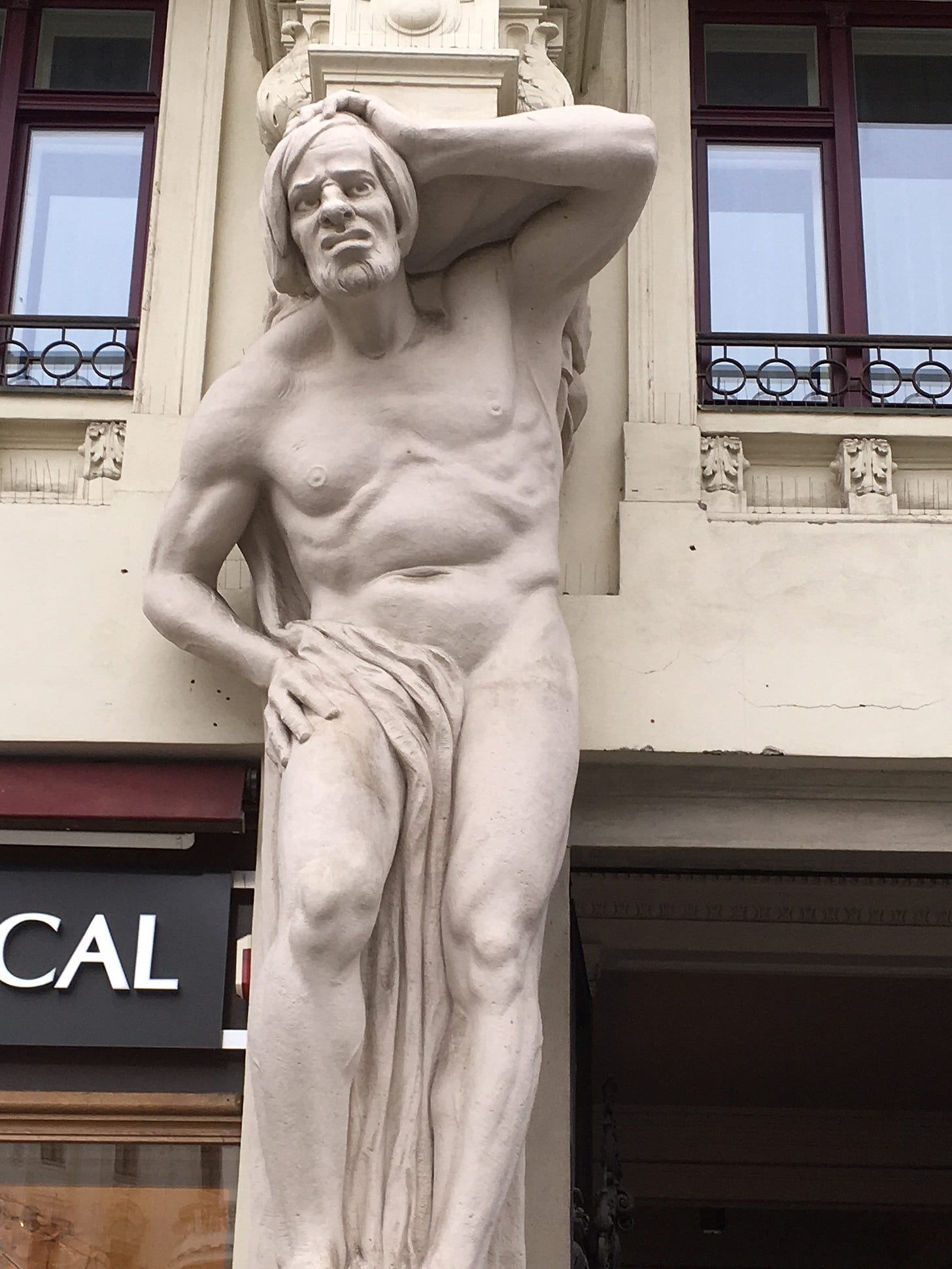
Practical Tips
Make the trip there as pleasant as possible. If we can ease stress during transit, we will arrive at our destination raring to go instead of hankering for a starchy meal and a soft bed. Alison suggests “tak[ing] food with you on the plane, especially when traveling with kids! … Take things to do—a book, an iPad with movies preloaded, or puzzles, because inflight entertainment doesn’t always work.” Fatima, who is a medical professional, recommends “Every two hours or sooner, get[ting] up and mov[ing] around. In between walks, point your toes up and around to squeeze your calf muscles and move that blood towards the heart.” Tammy, who knows this from bitter experience, urges anyone connecting through Charles de Gaulle in Paris to schedule enough time (at least two hours) to navigate the madness: “It felt like we went through security three times!”3 And Sarah has a simple idea for minimizing the time we (and our restless kids) are confined in those tiny airplane seats:
Save yourself heartache and get on the plane last. The way we seat people on planes is so dumb—would it, like, tip the plane over to just fill it in from the back rows first rather than the idiotic class-based system we have now? … The plane isn’t going anywhere. They’re not actually checking to make sure you got on with Group C, or whatever.
Take a siesta. As Tim says, “Keep in mind one’s limits, both with time and energy.” On every trip I take a midafternoon break to rest up, jot down notes about the day’s adventures, and have a glass of wine in the hotel lounge4 before sallying forth again. Or make your whole trip one big siesta! Not every trip needs to be a fitness challenge or a forced march through culture. A friend once told me that her favorite vacation was one where she and her husband didn’t try to improve themselves in any way but just relaxed on the beach. But in fact we are also improving ourselves when we relax!
Get active and use all your senses. When we’re traveling, we often fall back on using only our eyes, and not our other senses. Or, as my nephew, at the time a little kid, said on a visit to us in Prague, “we just walk around looking at things.” He was absolutely right, and my smart sister-in-law Robin found a scavenger hunt for our families to do together. We had a terrific time challenging ourselves and exploring the city, and we learned much more than we would have otherwise. Many cities offer scavenger hunts and other active ways of experiencing a new place.
Our family has also visited spas in Bavaria and Budapest to enjoy a hot soak on a chilly day. In both places we were the only Americans there, and so we got a fascinating glimpse into the local culture.
Other multi-sensory experiences include cooking classes, wine tastings, bike tours, and concerts. Many cities have special tourist concerts that last about an hour, feature the composers and musical styles of the region, give us access to grand concert halls and cathedrals, and require no advance booking—you can just show up. These concerts are a wonderful introduction to the music and culture of the country you’re visiting, and the musicians are highly accomplished. As for me, the next time we’re in Italy, I’d like to try the perfect excursion for dog-lovers and foodies alike: truffle-hunting with a farmer and his dogs.
Avoid becoming overwhelmed at museums. When we visit a museum in a new city, it can feel as though this is our one chance to see absolutely everything on display, and so we visit every room and cast our eyes over every single painting, sculpture, urn, and tapestry. This attitude is understandable, but it sets us up for exhaustion, headaches, arguments, and maybe even Stendahl syndrome. Our visits will be much more pleasant if we strategize beforehand. For example, I have found the museum tours in the Rick Steves guidebooks to be insightful and also helpful in paring down what we see to the most interesting works; Rick Steves museum tours can also be downloaded to our phones for free. Most museums offer their own guided tours for a small additional fee, and these are a great way to narrow our focus and learn a lot too. Karla, a museum professional, has a helpful suggestion:
At those huge museums, take a quick glance at the gift shop postcard rack before entering the galleries, just so you don’t discover, too late at closing, that you missed something wonderful or famous you have always wanted to see.
Another idea is to figure out in advance which objects in the museum we absolutely must see—and then to allow ourselves to skip everything else, even if that means we see only a few works. I know this sounds like heresy; seeing only one or two items goes against our wish to get our money’s worth from our ticket. We can counter the sunk-cost fallacy by purchasing a tourist card. Tourist cards admit you to multiple museums and cultural sites and sometimes allow you to skip lines too. Most major European cities offer them in lengths ranging from a day to a week. With a tourist card, it feels like all the museums are “free,” so you can pop in to see a couple of paintings and then skedaddle.
Accept help if you need it. I asked Casey for tips for travelers with disabilities, and she suggests the following:
Have a mental and physical list of things you need to do so you aren’t trying to remember while you are also stressed about time;
Fellow passengers might help you with small things, but not if they’re in a hurry—asking someone you’ve met before is more effective;
If you have items that make existing easier (pain pills, headphones, snacks, etc.), always assume you’ll need them easily accessible—it’s better to have and not need them than need and not have them;
Let the bus driver, TSA agent, or other workers know you’re disabled before the need for help arises; and
Know your rights! Wheelchair compartments on planes are, in fact, for wheelchairs.
Janelle adds,
I have a doctor’s note saying I have mobility issues. When I flew alone, they’d have someone push me in a wheelchair to and from the gate, and I had first boarding priority. … We also usually ask for ADA hotel rooms that aren’t as far from exits or elevators and have accessible showers with grab bars and seats.
On family trips, we always book a hotel close to the center to minimize the amount of walking we have to do. We have also occasionally splurged on a horse and buggy tour so that Casey can get an overview of the city in a fun way.
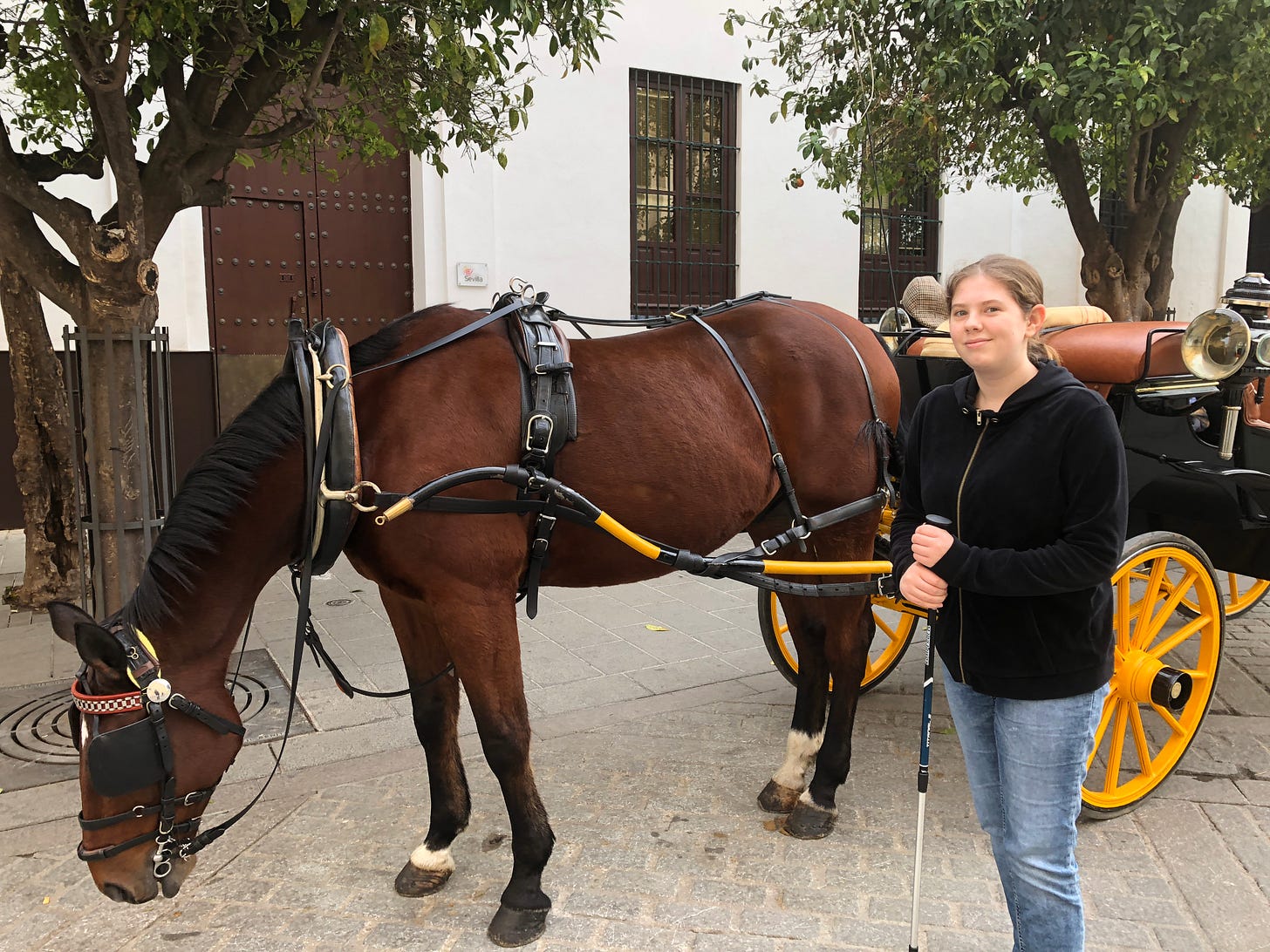
I hope these tips have been helpful and have inspired you to embark on that adventure you’ve been contemplating! And remember to stay tuned, because there is more to come next week!
How about you, readers? What are your best travel tips? Please share your thoughts in the comments!
The Tidbit
Whether traveling or at home, I am an extremely tidy and organized person, and so I found this cartoon quite appealing:

Because we do all our traveling in Europe, a few of these tips are specific to Europe, but most of them apply everywhere.
A water bottle is a necessity because, in my experience, Europe is weirdly stingy about water. It is rare for cities to have public drinking fountains, and when you and your parched family request water in restaurants, the waiter will often return with a single, miserly bottle for all of you.
I concur! You can read about our family’s harrowing ninety-minute connection with our dog in tow at Charles de Gaulle here.
One hotel we stayed in served wine on a balcony overlooking an atrium and—we discovered—an opera teacher’s studio. It was a treat to be serenaded as I sipped my wine.

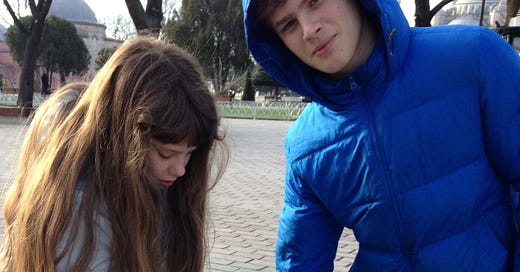


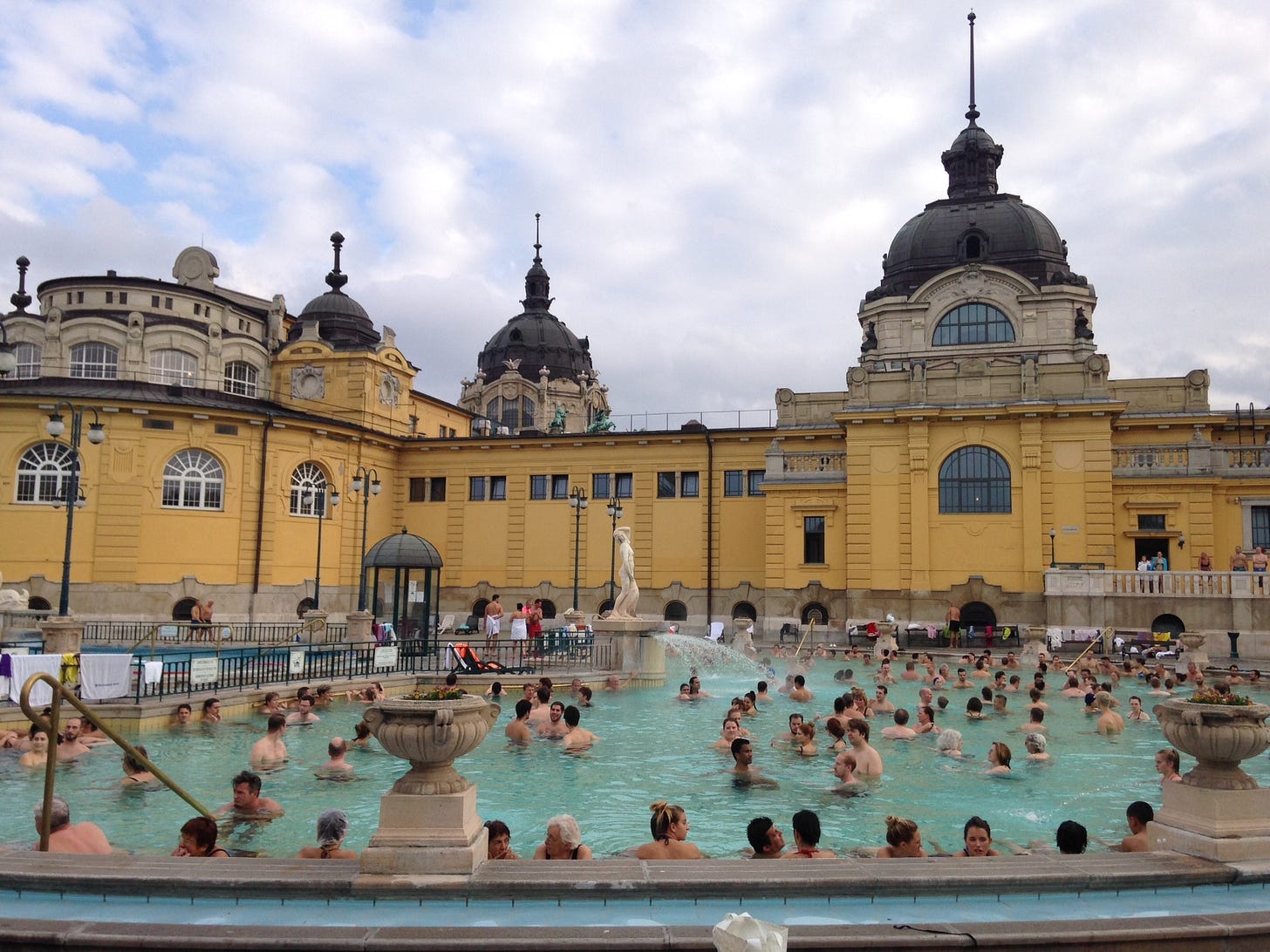
Great tips and thanks for sharing. I have to remind myself that I am fortunate to travel. Many times when I explore I pause to soak up the moment in gratitude. It's a special experience for sure and we have to roll with the punches! Thanks for the read.
Great tips! My personal favorites are Tim's tip to take a siesta and Casey's tip about your meds. I take several medications, and that's always priority one when packing. As when I was young and careless I put myself into a few tough spots with many hours on the phone to my doctor, which is no way to spend a vacation lol.